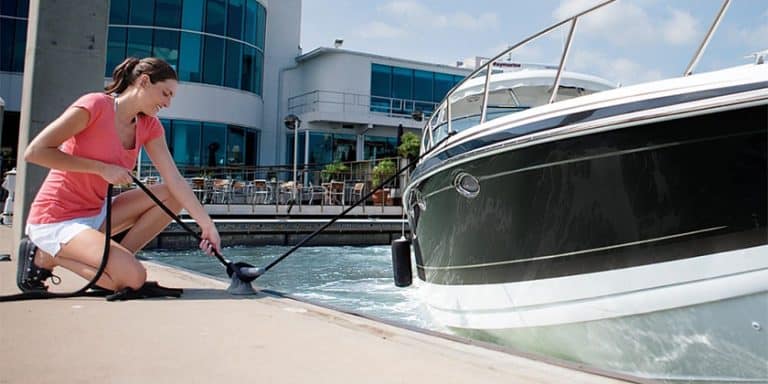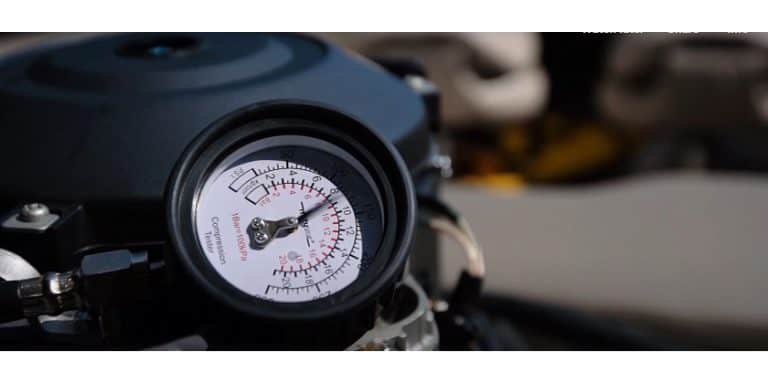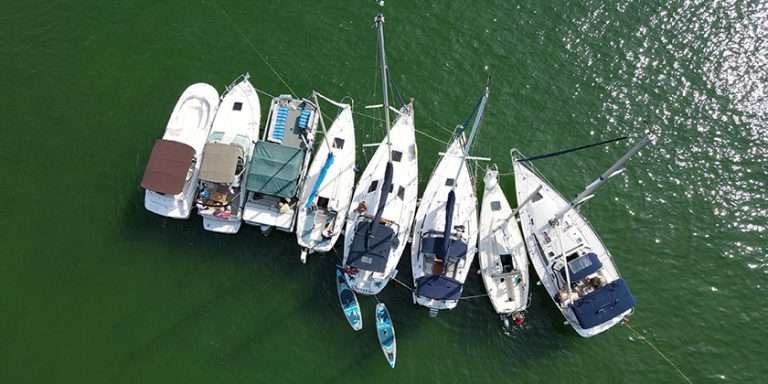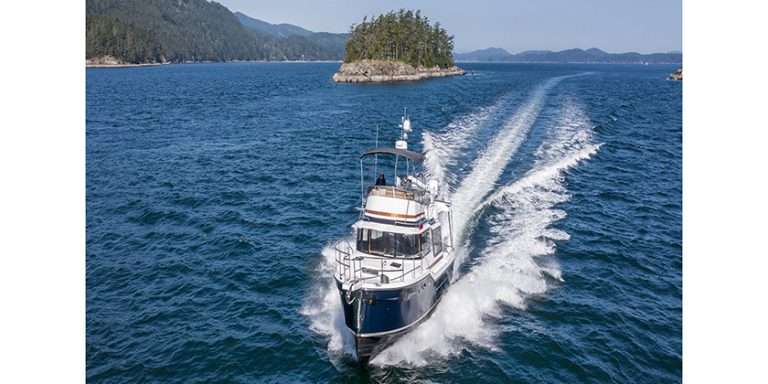`Boating Oops Awards 2014

By Larry MacDonald
Drum roll, please: We present a year’s worth of boating blunders…that we all can learn from.
Here are the Top 10 boating blunders reported to me in the past year:
The Dumb
10. Anchor Away Gary had chartered a nearly new sailboat and was anchoring for the first time. With his wife at the helm, he dropped the hook and fed out 50′ of chain, then continued to let out the rope. Thinking his wife was backing up too quickly, he asked her to slow down, which she did − but not before the rode’s bitter end slipped through Gary’s hands. It had not been tied off in the anchor locker. They were able to dock for the night at a nearby marina and the next morning, the charter company retrieved the ground tackle and extended their charter for two days to compensate them for this very avoidable mishap.
Tip: Make sure the bitter end of your anchor rode is secured to your boat, and be aware that charter boats, especially new ones, may have unresolved problems.
9. Sssssssss… Ben and Ron were on a sailing charter in Florida when they decided to anchor in a narrow waterway. Ron rowed their inflatable dinghy to shore to tie off a stern line. While doing so, he accidentally rammed into a sharp branch, puncturing one side of the dinghy. Ben wisely shouted: “Untie the line,” which Ron did before rowing frantically back to the boat in the half-submerged tender. They spent the next day searching for a patch kit without success. Eventually, a fellow boater generously lent them his kit to make the repair.
Tip: If you have an inflatable, always carry an appropriate patch kit. You never know when you, or a fellow boater, might need it.
8. Twisted Motoring into a secluded bay, Chris selected his spot to drop anchor. While reversing to set the hook, he heard a screech and the engine started labouring. After shutting down the engine, he noticed the dinghy painter leading directly under the boat, obviously wrapped around the prop shaft. It took him multiple dives in frigid water to free the line, and an extra ration of rum to ease the pain.
Tip: Use floating line such as polypropylene for tender painters and towlines – they’ll be much less likely to foul underwater running gear. As a reminder to shorten the line before anchoring or docking, tie the bitter end to your anchoring gloves or fenders.
7. Docking 101 Newbie sailors Dave and Carol were practising docking their new 34′ sailboat. Dave made an angled approach while Carol stood outside the pulpit, dockline in hand. As the bow reached the dock, Carol realized she could injure herself by landing on the tie rail so she turned her back to the dock and stepped off. At that moment, Dave turned the boat parallel to the dock, swinging the bow far enough away that Carol stepped into midair and…Splash! Fortunately, she was able to swim to a nearby ladder while Dave tied up the boat.
Tip: Stop the boat close enough to the dock that crew can step safely off from amidships or aft, never from the bow.
6. Not So Merry-Go-Round Jim, a BC kayaker, attempted to paddle through a tidal pass at high tide, which he assumed would be slack water. His assumption nearly proved fatal: he was caught in a school bus-sized whirlpool, which dumped him and his gear into the salt chuck. Hanging on to his kayak and paddling furiously with his feet through several revolutions, he managed to break free and make it to shore. When he related this story, I explained that high (or low) tide and slack current in tidal passes seldom coincide and can be more than an hour apart. Consult local Tide and Current Tables to determine when it’s safe to transit a pass or rapids.
Tip: All boaters in Canadian coastal waters should have the local Tide and Current Tables and know how to read them.
The Dumber
5. Ouch! On one of my cruise-and-learn courses, I explained to students the importance of securing the anchor hatch in the open position with the bungee cord provided. A few days later, Robert was raising the anchor with the electric windlass when wake from a passing yacht caused our boat to roll slightly, just enough to tip the hatch past vertical. Robert’s hand was on the casing when the hatch slammed down on it. It was not a pretty sight. After providing first aid, I arranged for him to be transported to a local hospital where he was treated for severe cuts and a broken finger. Later, Robert admitted he had learned a lesson the hard way, “not exactly what I had in mind when I signed up for a cruise-and-learn.”
Tip: Make sure open hatches are secured when working around them.
4. Cardinal Rules In a popular BC anchorage, I noticed a large sailing yacht approaching the east side of a west cardinal buoy. Just as I thought “this is going to hurt,” the boat hit the submerged reef and came to rest at a rakish angle. The elderly skipper and his wife were uninjured and their steel hull was not leaking so, after helping them kedge off, I asked the skipper what the marker meant to him. “I thought it marked an isolated rock that I could pass on either side,” as he said he had done on previous occasions, obviously at higher tides. I suggested he become familiar with cardinal buoys, which are common in BC coastal waters: they use compass cardinal points to indicate where mariners will find deep water and safe passage around obstructions.
Tip: Boaters familiar with Nanaimo Harbour will know the buoy in question, labeled ‘PS’ and marking Satellite Reef, which dries at low tide. Stay west of PS.
3. Log Boom Rick was returning solo from a classic boat show in his restored 42′ wooden powerboat. Proceeding on autopilot, he felt the urge to use the head so he scanned ahead for traffic and decided all was clear, then stepped below. It couldn’t have been more than four minutes before he heard a loud “boom.” Returning to the helm, he noticed a partly submerged log behind the boat which he had obviously hit. Fortunately, the hull was intact but his starboard engine was running roughly so he shut it down and limped home on one engine. Later, he discovered the log had badly damaged his starboard prop, which he replaced at a cost of $600. Rick told me, “It was a very expensive pee.”
Tip: If you have to leave the helm unattended for any reason, stop the boat. You can’t collide with anything when you’re not moving.
2. Shortcut to the Hard Most accidental groundings occur when the skipper is below and a crewmember decides to take a shortcut. Ken, a novice boater, made a beeline for the intended anchorage while the skipper was below searching for a chart. Crunch! The sailboat’s keel plowed onto a rocky shoal and the boat came to an abrupt stop. Aided by a rising tide and a passing powerboater who provided a deliberate wake, the skipper backed off and entered the anchorage through the safe channel. Ken said he had never fully appreciated, until that moment, “how much deep and shallow water look the same.”
Tip: Before leaving the helm, the skipper (or any other helmsperson) should provide course directions to the person taking the helm, especially when approaching waters that hide hazards.
The Dumbest
1. Shaken and Stirred Mary and Janet were good friends who decided to fulfill their lifelong dream of getting involved in boating. They began searching for a powerboat that would take them to popular destinations along the Inside Passage. They responded to an ad for a 32′ cabin cruiser, old but well kept. As soon as they stepped aboard, they knew they had to have it. Their offer was accepted by the owner and, after an orientation on the boat’s systems, they motored for home. But they hadn’t had the boat surveyed, they had no boating knowledge or experience, and they hadn’t checked the weather. Why should they, they reasoned: this was a big solid boat and all they had to do was drive it home, about 30 miles across an open stretch of ocean. An hour out, the weather deteriorated, the sea turned rough and the engine quit. Although they were so seasick they could hardly talk, they managed to contact the coast guard who dispatched a rescue vessel which towed them to the closest marina. This incident could have had far more serious consequences, so Mary and Janet win this year’s Boating ‘Oops’ Award. They have since taken boating courses through a Canadian Power and Sail Squadron and a cruise-and-learn on their own boat, enabling them to follow their dream in a more competent fashion.
Tip: Know before you go.
Thanks to those who shared their unfortunate experiences with me so that others can benefit from their mistakes. If you have done something equally dumb or even dumber, email me (CaptnMac@shaw.ca), describing the mishap and how it might have been prevented. Yes, we alter names to protect the responsible parties. Who knows: you just might qualify for a Boating ‘Oops’ Award next year!
Larry MacDonald is a freelance journalist from Powell River BC who writes about his sailing adventures in various cruising destinations. He enjoys teaching about his favourite pastime, in a classroom course for the Canadian Power and Sail Squadrons or on a cruise-and-learn on a chartered sailboat.




























